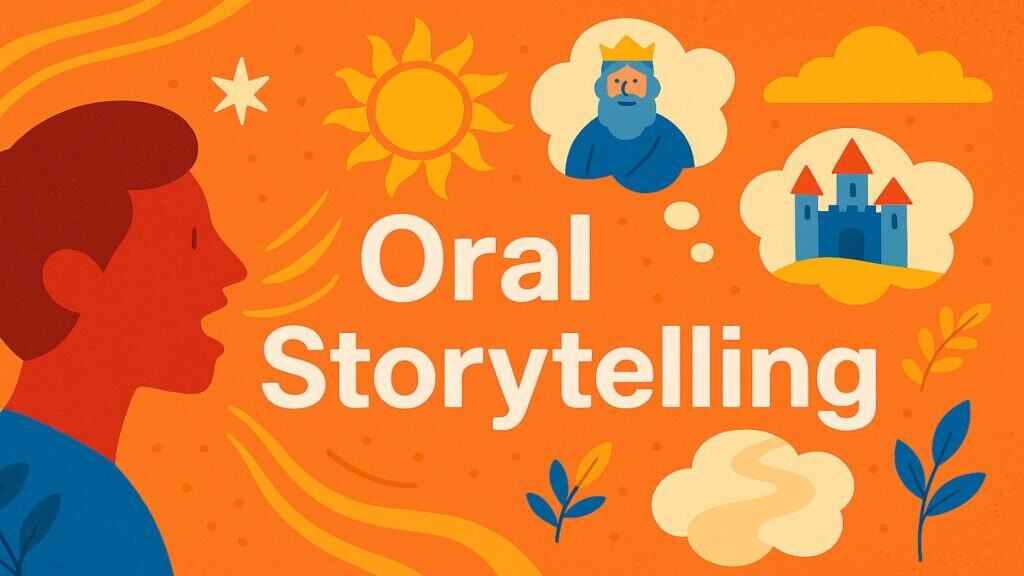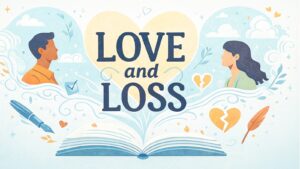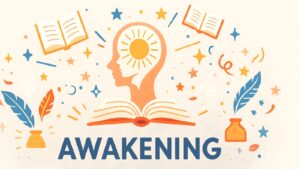Table of Contents
Introduction: Oral Storytelling – Humanity’s Original Creative Fire
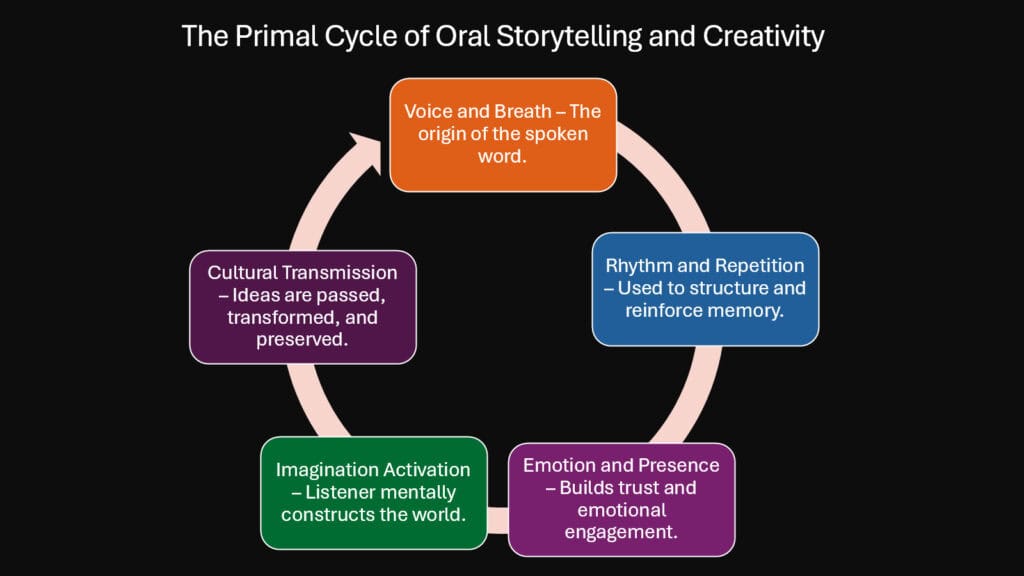
Before writing systems emerged and long before digital media transformed communication, humans gathered around fires to share stories. These moments created something profound—a primal creative force that still pulses through our collective consciousness today. Oral storytelling represents humanity’s first and most enduring creative medium, one that continues to ignite imagination and foster innovation across cultures worldwide.
Unlike other storytelling formats, oral storytelling demands immediate presence and authentic human connection. While prose offers structured literary devices and poetry provides rhythmic beauty, oral storytelling creates living, breathing narratives that shift with each telling. Graphic narratives rely on visual elements to convey meaning, and dramatic scripts depend on staged performances, but oral storytelling needs only voice, gesture, and the electric connection between teller and listener.
This ancient art form serves as creativity’s foundational training ground. When storytellers weave tales without written scripts, they develop improvisational skills that enhance creative thinking. The sensory richness of spoken narratives teaches minds to visualize complex scenarios and emotional landscapes. Through shared cultural symbols and archetypal characters, oral storytelling builds bridges between individual imagination and collective memory.
The creative power of oral storytelling extends beyond entertainment. It shapes how we process information, solve problems, and generate new ideas. Modern research reveals that storytelling activates multiple brain regions simultaneously, creating neural pathways that strengthen creative thinking. This article explores six remarkable ways oral storytelling continues to spark creativity in our contemporary world.
Core Elements of Oral Storytelling Formats
| Format | Primary Medium | Creative Strength | Audience Engagement |
|---|---|---|---|
| Oral Storytelling | Voice and presence | Improvisation and immediate adaptation | Direct interaction and co-creation |
| Prose | Written text | Detailed narrative structure | Individual interpretation |
| Poetry | Rhythmic language | Condensed emotional impact | Aesthetic appreciation |
| Graphic Narrative | Visual and textual elements | Visual storytelling synthesis | Multi-sensory experience |
| Dramatic Scripts | Performance dialogue | Character development | Theatrical immersion |
1. Oral Storytelling Ignites Imagery Through Sensory Language
Oral storytelling transforms abstract concepts into vivid mental experiences through carefully crafted sensory language. When storytellers describe the creak of ancient floorboards or the metallic taste of fear, they activate listeners’ sensory memories and imagination simultaneously. This process creates what researchers call “embodied cognition”—the mind’s ability to understand ideas through physical sensations and mental imagery.
The absence of visual aids in oral storytelling actually strengthens creative visualization. Listeners must construct entire worlds from words alone, engaging their imagination more actively than passive media consumption allows. This mental construction process exercises the same neural pathways used in creative problem-solving and innovative thinking. Each listener creates a unique internal version of the story, making every telling a collaborative creative act.
Master storytellers employ sophisticated techniques to maintain engagement and build suspense. They use flashbacks to reveal crucial background information at precisely the right moment, creating “aha” moments that satisfy listeners’ curiosity. Flashforwards offer tantalizing glimpses of future events, building anticipation and encouraging active listening. These temporal manipulations require creative thinking from both teller and audience.
Cliffhangers serve as powerful creative devices in oral storytelling. Unlike written narratives where readers can immediately turn the page, oral cliffhangers create genuine suspense. The storyteller controls pacing and revelation, building tension through strategic pauses and voice modulation. This technique teaches creative timing—understanding when to reveal information and when to withhold it for maximum impact.
The concept of Chekhov’s Gun—every element in a story should serve a purpose—takes on special significance in oral storytelling. Without written reference, storytellers must remember to resolve every introduced element. This constraint forces creative efficiency and teaches the importance of purposeful detail in creative work. Elements introduced early in the telling must pay off later, creating satisfying narrative closure.
Sensory Language Techniques in Oral Storytelling
| Technique | Purpose | Creative Impact | Example Application |
|---|---|---|---|
| Vivid Imagery | Activate listener imagination | Strengthens visualization skills | Describing settings without visual aids |
| Flashbacks | Reveal background strategically | Teaches narrative timing | Unveiling character motivations |
| Flashforwards | Build anticipation | Creates suspense management | Hinting at story resolution |
| Cliffhangers | Maintain engagement | Develops pacing awareness | Strategic information withholding |
| Chekhov’s Gun | Ensure narrative purpose | Promotes creative efficiency | Meaningful detail integration |
2. Oral Storytelling Unlocks Improvisation and Spontaneity
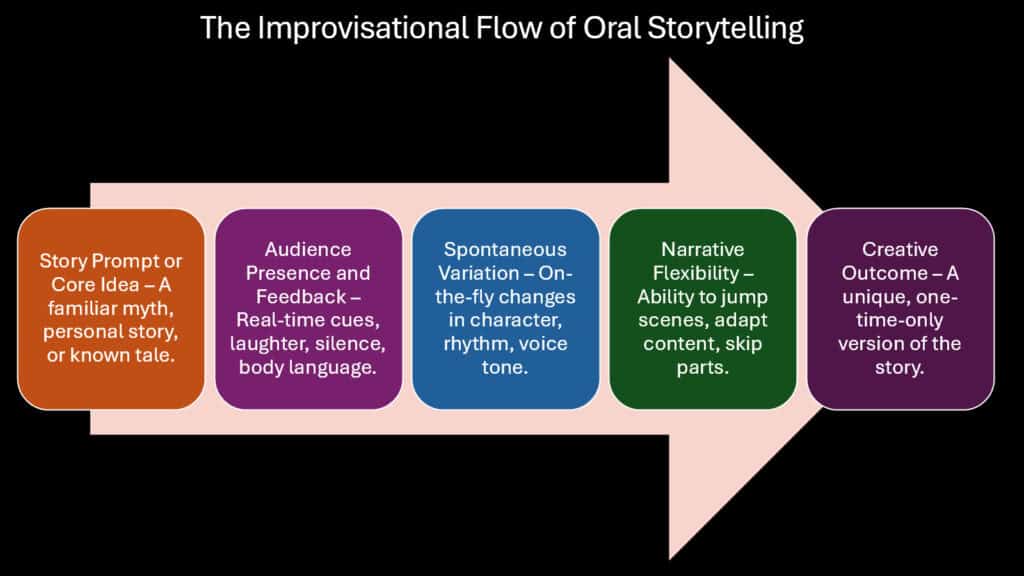
The absence of written scripts in oral storytelling creates unique opportunities for creative improvisation. Storytellers must adapt their narratives in real-time, responding to audience reactions, environmental changes, and their own creative impulses. This spontaneous adaptation builds mental flexibility and creative confidence. Unlike actors following predetermined scripts, oral storytellers become creative partners with their material, constantly reshaping and refining their narratives.
The “Show, Don’t Tell” principle becomes particularly powerful in oral storytelling. Without visual elements, storytellers must demonstrate character emotions and story developments through voice, gesture, and carefully chosen details. This constraint pushes creative boundaries, forcing storytellers to find innovative ways to convey complex information. The technique develops skills in creative communication that transfer to other artistic and professional endeavors.
Unreliable narration takes on special significance in oral storytelling. Storytellers can deliberately mislead audiences or present multiple perspectives on the same events. This technique requires sophisticated creative thinking—the ability to maintain multiple narrative threads while guiding listener interpretation. The spontaneous nature of oral delivery makes unreliable narration feel more authentic and engaging than written versions.
The In Medias Res technique—initiating narratives amidst action—fosters instant engagement and showcases a sophisticated creative framework. Oral storytellers who begin tales mid-scene must quickly establish context while maintaining momentum. This approach teaches creative economy, showing how to capture attention immediately and provide necessary background information without losing narrative drive.
Improvisation in oral storytelling develops what creativity researchers call “divergent thinking”—the ability to generate multiple solutions to problems. When storytellers encounter unexpected situations or audience reactions, they must quickly adapt their narratives. This real-time creative problem-solving strengthens mental agility and builds confidence in creative expression.
Improvisational Techniques in Oral Storytelling
| Technique | Creative Challenge | Skill Development | Practical Application |
|---|---|---|---|
| Show, Don’t Tell | Convey without visuals | Creative communication | Demonstrating through voice and gesture |
| Unreliable Narrative | Maintain multiple perspectives | Complex thinking | Deliberate misdirection and revelation |
| In Medias Res | Start mid-action | Immediate engagement | Capturing attention quickly |
| Real-time Adaptation | Respond to audience | Mental flexibility | Adjusting to unexpected reactions |
| Spontaneous Detail | Add elements instantly | Creative confidence | Enriching narratives on the spot |
3. Oral Storytelling Shapes Collective Memory and Myth-Making
Archetypal Criticism reveals how oral storytelling draws on deep, shared symbols to spark creative myth-making. Carl Jung’s concept of archetypes—universal patterns of character and situation that recur across cultures—finds its purest expression in oral narratives. These timeless figures like the Hero, the Trickster, and the Wise Elder appear in stories worldwide, suggesting fundamental creative patterns that transcend cultural boundaries.
Oral storytelling serves as humanity’s primary method for creating and transmitting collective memory. Unlike written records that preserve specific details, oral narratives evolve with each telling, allowing communities to update their shared stories while maintaining essential truths. This dynamic process demonstrates how creativity emerges from the tension between preservation and innovation. Each generation adds new layers of meaning while honoring ancestral wisdom.
The mythmaking function of oral storytelling reveals creativity’s role in meaning-making. When communities face unexplained phenomena or social challenges, storytellers create narratives that provide understanding and guidance. These mythic narratives don’t simply record events—they transform raw experience into meaningful patterns that inform future action. This transformative process exemplifies creativity’s power to generate new understanding from existing materials.
Archetypal characters in oral storytelling provide creative templates that storytellers can adapt to contemporary circumstances. The Hero’s journey, identified by Joseph Campbell, appears in countless oral traditions because it reflects fundamental human experiences of growth and transformation. Modern storytellers draw on these archetypal patterns, demonstrating how ancient creative wisdom remains relevant in contemporary contexts.
The collective nature of oral storytelling creates unique opportunities for creative collaboration. Unlike solitary writing, oral narratives emerge from community interaction. Listeners contribute through their reactions, questions, and retellings, making stories living documents that reflect collective creativity. This collaborative process shows how individual creative expression can merge with group consciousness to produce something greater than either could achieve alone.
Archetypal Elements in Oral Storytelling Traditions
| Archetype | Universal Function | Creative Expression | Cultural Variation |
|---|---|---|---|
| Hero | Journey and transformation | Overcoming challenges | Local customs and values |
| Trickster | Disruption and wisdom | Clever problem-solving | Cultural humor and insight |
| Wise Elder | Guidance and knowledge | Teaching through story | Traditional wisdom systems |
| Shadow Figure | Opposition and growth | Creating conflict | Cultural fears and taboos |
| Mother Figure | Nurturing and protection | Emotional support | Family and community bonds |
4. Oral Storytelling Builds Metaphoric Thinking and Symbolic Layers
Metaphors and layered meanings in oral storytelling teach minds to see beyond literal interpretation and develop symbolic thinking. When storytellers describe a character’s heart as “heavy as stone” or compare life’s journey to “walking through fog,” they invite listeners to make creative connections between different domains of experience. This metaphoric thinking strengthens the cognitive flexibility essential for creative problem-solving and innovative thinking.
The oral tradition’s reliance on memorable imagery creates rich symbolic landscapes that listeners can explore and interpret. Unlike written metaphors that readers can revisit, oral metaphors must be immediately accessible yet complex enough to reward deeper consideration. This balance requires storytellers to craft symbols that work on multiple levels, developing skills in creative layering that enhance overall artistic expression.
Symbolic thinking in oral storytelling operates through what cognitive scientists call “conceptual blending”—the mental ability to combine different ideas to create new understanding. When listeners encounter symbolic narratives, they must blend the literal story elements with deeper meanings, creating personal interpretations that reflect their own experiences and insights. This active interpretive process strengthens creative thinking by exercising the mind’s capacity for making novel connections.
The temporal nature of oral storytelling creates unique opportunities for symbolic development. Storytellers can build symbolic meanings gradually, allowing metaphors to deepen and evolve throughout the narrative. This progressive revelation mirrors the creative process itself—ideas that begin simply can develop into complex, multilayered concepts through careful development and patient exploration.
Cultural symbols in oral storytelling serve as creative bridges between individual and collective meaning. When storytellers use traditional symbols like water representing life or fire symbolizing transformation, they tap into shared cultural knowledge while creating space for personal interpretation. This balance between universal and individual meaning demonstrates how creativity emerges from the interaction between established patterns and fresh perspectives.
Symbolic Elements in Oral Storytelling
| Symbol Type | Creative Function | Cognitive Impact | Cultural Significance |
|---|---|---|---|
| Natural Elements | Universal connections | Embodied understanding | Shared environmental experience |
| Journey Metaphors | Life progression | Temporal thinking | Common human experiences |
| Transformation Symbols | Change and growth | Dynamic thinking | Cultural values and beliefs |
| Seasonal Imagery | Cyclical patterns | Rhythmic awareness | Agricultural and natural cycles |
| Animal Symbolism | Character traits | Behavioral understanding | Cultural relationships with nature |
5. Oral Storytelling Activates the “Creative Unconscious”
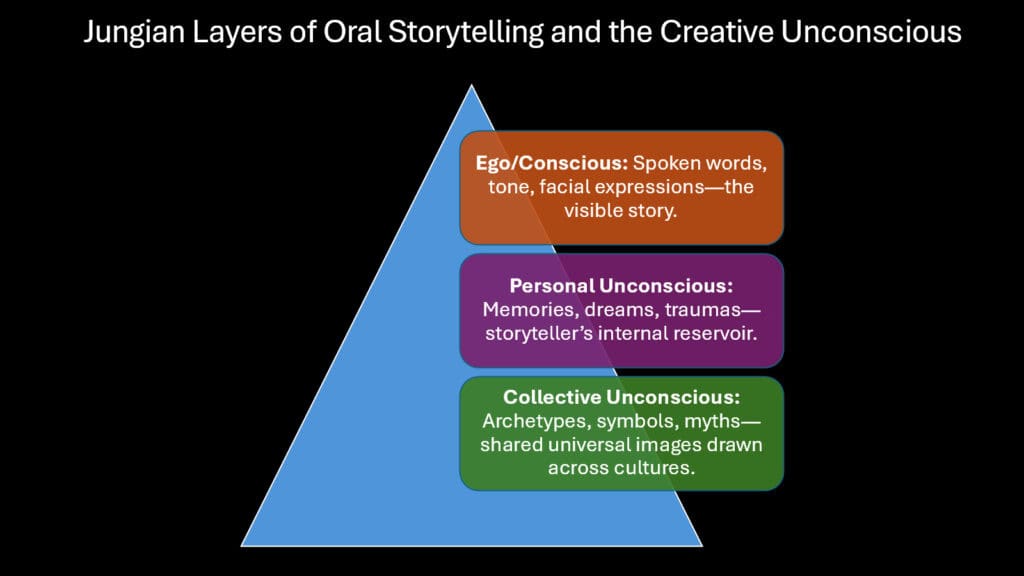
Jungian Theory reveals how oral storytelling opens gateways to the collective unconscious, pulling creative symbols from deep psychological layers. Carl Jung’s concept of the collective unconscious—shared mental patterns inherited from human evolutionary history—finds powerful expression in oral narratives. These stories access ancient creative resources that exist below conscious awareness, allowing storytellers and listeners to tap into humanity’s deepest creative wellspring.
The rhythmic, repetitive nature of oral storytelling creates altered states of consciousness that facilitate creative insight. When storytellers establish narrative rhythms through voice modulation and repetitive patterns, they induce trance-like states that bypass analytical thinking. These altered states allow creative material to emerge from unconscious sources, producing insights and connections that logical analysis might miss.
Dream imagery frequently appears in oral storytelling, reflecting the unconscious mind’s natural narrative tendencies. Jung observed that dreams and myths share similar symbolic languages, suggesting that oral storytelling taps into the same creative processes that generate dreams. This connection explains why oral narratives often feel simultaneously familiar and mysterious—they speak to unconscious patterns that all humans share.
The spontaneous nature of oral storytelling allows unconscious creative material to surface unexpectedly. Unlike carefully planned written works, oral narratives can incorporate sudden insights, unexpected connections, and intuitive leaps that emerge during the telling. This spontaneous creativity demonstrates how the unconscious mind contributes to artistic expression when given freedom to operate without excessive conscious control.
Active imagination—Jung’s therapeutic technique for engaging with unconscious material—parallels the creative process in oral storytelling. Both involve allowing images and narratives to emerge spontaneously while maintaining enough conscious direction to shape the experience meaningfully. This balance between conscious intention and unconscious flow creates optimal conditions for creative expression and psychological insight.
Jungian Elements in Oral Storytelling
| Unconscious Element | Creative Expression | Psychological Function | Storytelling Application |
|---|---|---|---|
| Collective Unconscious | Universal symbols | Shared human experience | Archetypal characters and themes |
| Personal Unconscious | Individual insights | Personal integration | Autobiographical elements |
| Shadow Integration | Confronting darkness | Psychological wholeness | Antagonists and moral complexity |
| Anima/Animus | Gender integration | Psychological balance | Character development and relationships |
| Individuation Process | Personal growth | Self-realization | Hero’s quest and transformation |
6. Oral Storytelling Transforms Listeners into Co-Creators
The interactive nature of oral storytelling transforms passive listeners into active creative participants. Unlike other narrative forms that present finished products, oral storytelling creates dynamic exchanges where audience responses shape the narrative’s development. This participatory element makes every telling a unique creative collaboration between storyteller and listeners, demonstrating how creativity emerges from human interaction rather than individual isolation.
Listeners contribute to oral narratives through their imagination, filling in details that storytellers leave unspecified. This creative participation requires active mental engagement, as listeners must construct visual scenes, emotional landscapes, and character motivations from verbal cues alone. The process strengthens imaginative capacity and develops creative confidence by making listeners partners in the storytelling process.
The retelling tradition in oral storytelling creates ongoing creative evolution. When listeners become storytellers themselves, they add personal interpretations, cultural perspectives, and creative embellishments to traditional narratives. This continuous creative transformation ensures that oral stories remain living documents that reflect contemporary relevance while maintaining connection to ancestral wisdom.
Audience feedback in oral storytelling provides immediate creative validation and direction. Storytellers adjust their narratives based on listener reactions, creating responsive creative processes that incorporate multiple perspectives. This real-time collaboration demonstrates how creativity benefits from interactive engagement rather than solitary development, showing the value of community input in creative work.
The memorization and personalization required in oral storytelling tradition develops creative ownership. When individuals learn stories to retell them, they must internalize narrative structures, character motivations, and thematic elements. This deep engagement with story materials creates opportunities for creative adaptation and personal expression within traditional frameworks.
Participatory Elements in Oral Storytelling
| Participation Type | Creative Contribution | Skill Development | Community Impact |
|---|---|---|---|
| Active Listening | Imaginative construction | Visualization skills | Shared narrative experience |
| Audience Response | Real-time feedback | Interactive creativity | Collective story shaping |
| Retelling Tradition | Personal interpretation | Creative adaptation | Cultural transmission |
| Memory Integration | Internalized narrative | Creative ownership | Personal storytelling ability |
| Collaborative Creation | Group story building | Collective creativity | Community bonding |
Conclusion: Oral Storytelling – The Timeless Engine of Human Creativity
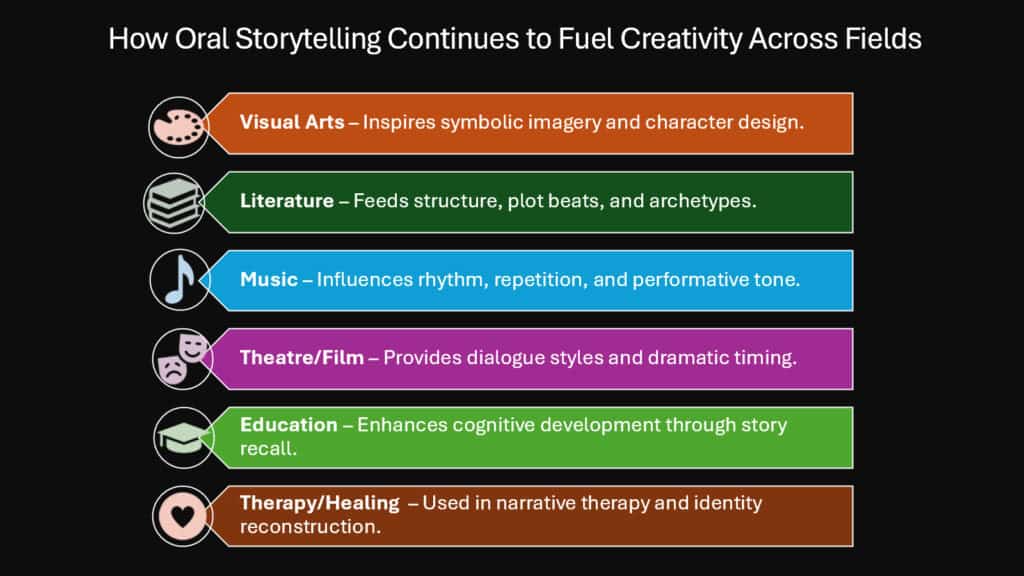
Oral storytelling continues to inspire artists, thinkers, and everyday minds by keeping the creative spark alive through words, breath, and memory. This ancient art form demonstrates that creativity emerges not from technological sophistication but from fundamental human capacities for imagination, connection, and meaning-making. The six ways oral storytelling sparks creativity—sensory imagery, improvisation, mythmaking, symbolic thinking, unconscious activation, and participatory creation—reveal essential creative principles that remain relevant across all artistic endeavors.
The enduring power of oral storytelling lies in its ability to transform both teller and listener through shared creative experience. Unlike passive media consumption, oral narratives demand active participation, creating opportunities for creative growth and personal development. This interactive nature makes oral storytelling a powerful educational tool that develops creative thinking, communication skills, and cultural awareness simultaneously.
Modern applications of oral storytelling principles can enhance creativity in various contexts. Business leaders use storytelling techniques to inspire teams and communicate vision. Educators employ narrative methods to make learning more engaging and memorable. Therapists utilize story-based approaches to help clients process experiences and develop new perspectives. These applications demonstrate oral storytelling’s continued relevance in contemporary creative practice.
The digital age has not diminished oral storytelling’s creative power but has provided new platforms for its expression. Podcasts, live streaming, and virtual reality experiences offer innovative ways to share oral narratives while maintaining the essential elements of voice, presence, and interaction. These technological tools expand oral storytelling’s reach while preserving its fundamental creative principles.
Essential Creative Principles from Oral Storytelling
| Principle | Creative Application | Modern Relevance | Practical Implementation |
|---|---|---|---|
| Sensory Engagement | Vivid communication | Media and design | Rich descriptive language |
| Improvisational Thinking | Adaptive creativity | Innovation and problem-solving | Flexible response to challenges |
| Archetypal Wisdom | Universal patterns | Cross-cultural communication | Timeless character and theme usage |
| Symbolic Depth | Layered meaning | Artistic expression | Metaphorical thinking development |
| Unconscious Access | Intuitive creativity | Breakthrough innovation | Trusting creative instincts |
| Collaborative Creation | Interactive creativity | Team innovation | Inclusive creative processes |
The creative fire that oral storytelling ignites continues to burn brightly, offering timeless lessons for anyone seeking to enhance their creative capacity. By understanding and applying these principles, we can tap into humanity’s oldest creative tradition while addressing contemporary challenges and opportunities. How will you use the creative power of oral storytelling to spark innovation in your own work and life?

